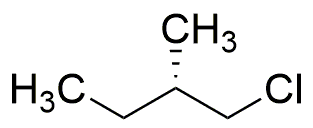(S)-(+)-1-Chloro-2-methylbutane is widely utilized in research focused on:
- Synthesis of Chiral Compounds: This chemical serves as a key intermediate in the synthesis of various chiral compounds, which are essential in pharmaceuticals for creating drugs with specific biological activity.
- Organic Synthesis: It is employed in organic synthesis reactions, particularly in the production of complex organic molecules, making it valuable for chemists in both academic and industrial settings.
- Flavor and Fragrance Industry: The compound is used in the formulation of flavors and fragrances, providing unique scent profiles that enhance consumer products like perfumes and food items.
- Research in Asymmetric Synthesis: It plays a crucial role in asymmetric synthesis, allowing researchers to create compounds with desired stereochemistry, which is vital in developing new materials and drugs.
- Environmental Applications: Its properties make it useful in environmental chemistry for studying the behavior of chlorinated compounds, aiding in the development of methods for pollution control and remediation.
General Information
Properties
Safety and Regulations
Applications
(S)-(+)-1-Chloro-2-methylbutane is widely utilized in research focused on:
- Synthesis of Chiral Compounds: This chemical serves as a key intermediate in the synthesis of various chiral compounds, which are essential in pharmaceuticals for creating drugs with specific biological activity.
- Organic Synthesis: It is employed in organic synthesis reactions, particularly in the production of complex organic molecules, making it valuable for chemists in both academic and industrial settings.
- Flavor and Fragrance Industry: The compound is used in the formulation of flavors and fragrances, providing unique scent profiles that enhance consumer products like perfumes and food items.
- Research in Asymmetric Synthesis: It plays a crucial role in asymmetric synthesis, allowing researchers to create compounds with desired stereochemistry, which is vital in developing new materials and drugs.
- Environmental Applications: Its properties make it useful in environmental chemistry for studying the behavior of chlorinated compounds, aiding in the development of methods for pollution control and remediation.
Documents
Safety Data Sheets (SDS)
The SDS provides comprehensive safety information on handling, storage, and disposal of the product.
Product Specification (PS)
The PS provides a comprehensive breakdown of the product’s properties, including chemical composition, physical state, purity, and storage requirements. It also details acceptable quality ranges and the product's intended applications.
Certificates of Analysis (COA)
Search for Certificates of Analysis (COA) by entering the products Lot Number. Lot and Batch Numbers can be found on a product’s label following the words ‘Lot’ or ‘Batch’.
*Catalog Number
*Lot Number
Certificates Of Origin (COO)
This COO confirms the country where the product was manufactured, and also details the materials and components used in it and whether it is derived from natural, synthetic, or other specific sources. This certificate may be required for customs, trade, and regulatory compliance.
*Catalog Number
*Lot Number
Safety Data Sheets (SDS)
The SDS provides comprehensive safety information on handling, storage, and disposal of the product.
DownloadProduct Specification (PS)
The PS provides a comprehensive breakdown of the product’s properties, including chemical composition, physical state, purity, and storage requirements. It also details acceptable quality ranges and the product's intended applications.
DownloadCertificates of Analysis (COA)
Search for Certificates of Analysis (COA) by entering the products Lot Number. Lot and Batch Numbers can be found on a product’s label following the words ‘Lot’ or ‘Batch’.
*Catalog Number
*Lot Number
Certificates Of Origin (COO)
This COO confirms the country where the product was manufactured, and also details the materials and components used in it and whether it is derived from natural, synthetic, or other specific sources. This certificate may be required for customs, trade, and regulatory compliance.

